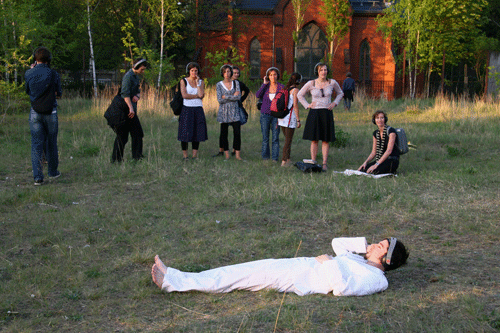 Image: Mitting by Oliver Hangl urban interface:berlin funded by Hauptstadtkulturfonds Berlin April 2007 Go to website of urban interface: berlin Electronic, digital and mobile media deeply change the city, which thereby is transformed into a media-based, all-time accessible platform and a multi-faceted space of perception. The ubiquitous use of digital, networked and mobile media in our everyday environment raises new questions about the features and definitions of both private and public space. Invisible surveillance systems and spy bots, the semi-private forums of on-line chats, the use of the cell phone in public space, and wireless access to the internet -- they all have a strong impact on our understanding of private and public space – and they demand for more precise and accurate definitions and demarcations of these spaces. Particularly the 70’s and 80’s celebrated the idea of new technology as for paving the ground for a open, democratic and networked society. Albeit most of these high and idealistic expectations of those years were not delivered, new media still inhere the potential of inter-cultural and inter-social communication. By the same token, they are capable of occupying real and fictional spaces, and of acting as a transmitter between private and public space. The project urban interface: berlin reacts on this complex situation and places media art into the interspaces of the private and the public. Distinctive art projects will become visible at non-places, at inconspicuous places, in niches and transit spaces between the private and the public. Image-based installations and sound pieces break in on the passerby, and direct his attention to these spaces. Spaces that have been blanks on the cultural map of Berlin will be filled temporarily with media art and thereby interpreted by the artists. Data projections on house walls, sound installations in unimposing passageways, in cars, network pieces on parking sites, in front gardens and on roofs will call for attention and demand for a closer investigation of what today constitutes private and public space. The artworks are not anonymously placed in these interspaces, but are strongly associated with their hosts providing them space and thus “communicating” them to the public. Each artwork is selected for a particular venue in cooperation with the hosts, which can be either private citizens offering their home or real estate, or enterprises. Naturally, this selection accounts for a precise analysis of the conditions and notions of the offered space. Ideally, the artwork will reflect on these conditions and notions, thus emphasizing or revealing the cultural context of the space. For the period of exhibition, the hosts should understand themselves as communicators and transmitters, whereas the project deliberately leaves it to the hosts, how they execute their role. The unusual practice of involving private citizens and sponsors in the content of a cultural operation attempts as well to identify the potential and risks of private-public-partnerships and art sponsoring. Against the background of limited financial resources for art funding, companies and foundations tend to use culture and art rather as a strategic means of public relations than for ethic or social reasons. Generally, it can be observed that their influence on the content of cultural activities increases. Here the project urban interface: berlin is proactive and deals with the situation in a creative and critical way. It is to identify the common interests of the artist, curator and the sponsor. Is hosting an artwork but attractive when it offers the host ways to communicate himself or their brand? Or: Has a single event or a single cultural activity by one host any deeper or long-lasting impact on the recognition of public and private space? Or: How much freedom is given by the host to the artist, when the host is confronted with the artistic result every day? |
||||||||

